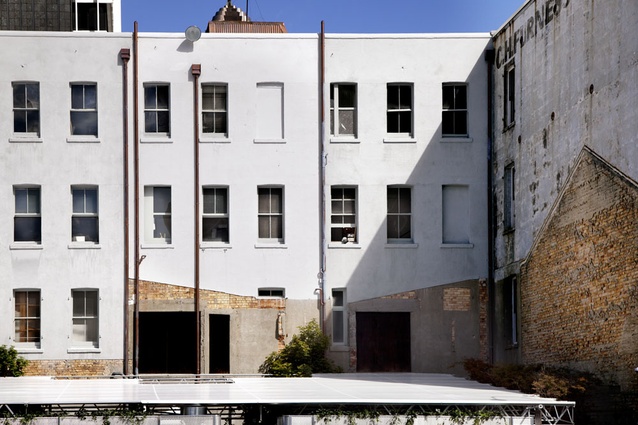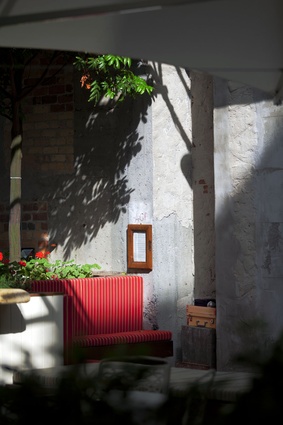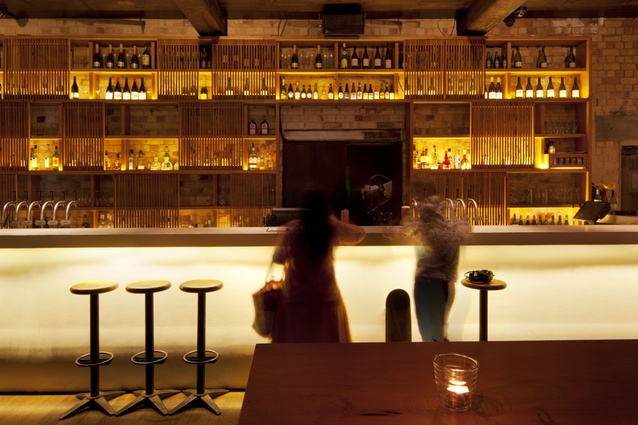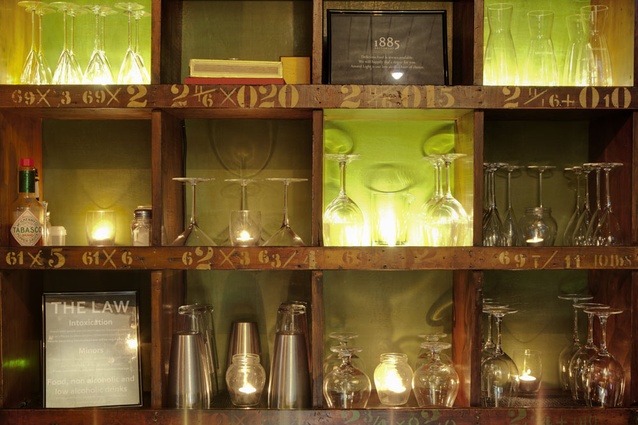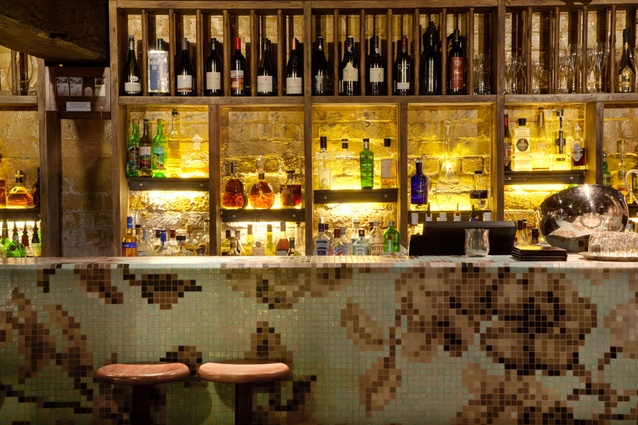Squaring up at Britomart
Nat Cheshire has a masochistic streak — he loves old buildings. He talks with Interior magazine editor Michael Barrett about Cheshire Architects’ hospitality work at Britomart Square, Auckland.
Michael Barrett\ How did you end up working down here?
Nat Cheshire\ Pip [Cheshire] was the master architect for the precinct as a whole. He set up the urban form and the urban strategy for the organic growth of Britomart: what that meant at the public level in terms of its squares and so on, and also in the public-private interaction; the relationship between these big old buildings which have their own idiosyncrasies, and the city outside and between them.
MB\ That plan has evolved a bit over time, hasn’t it?
NC\ Initially we were involved in the conversion of the Maritime and Northern Steamship buildings. We then scaled-up, and did a scheme for a mixed-use conversion of Stanbeth and Excelsior — high quality residential apartments and offices on the upper levels, and retail at street level. We did a huge amount of work on that, and then the market changed and it no longer made sense. So the project stopped. That’s the reality of city-making: it’s a highly fluid environment. Two years later we got a call from an energetic young project manager at Cooper & Co — the precinct owners — who had this bar operator keen on doing something on the ground floor. They needed us to do some quick modifications of the old plans to fit them in. I came down and met with Nick McCaw, just because Pip and the original project architect weren’t around. Nick’s energy and intelligence was inspiriting. This, coupled with incredible raw power of the buildings, and the commitment of the owners — it seemed like a really hot mix. So I just stopped sleeping, and went for the jugular — we did everything we could to make the project real. The whole relationship has been built from that first encounter.
MB\ Was it always planned to be a series of venues?
NC\ Like the precinct, the growth is organic. It started with Racket and Agents & Merchants. Nick and his team did all that straight out of Christchurch, I hadn’t met them at that stage. When they fixed their sights on Stanbeth and Excelsior, it was with a view to delivering a substantial hospitality environment, big in both breadth and depth. Gradually, Ponsonby operators Tony McGeorge and Krishna Botica got excited about the restaurant space and peeled that off as a project of their own, but it always retained a synergy of service and treatment. Nick and I had been toying with schemes for the carpark next door for ages — hotels, bars, all sorts. When we finished 1885, it made most sense to form a sort of hedge-fund against the weather, and expand their offering with a much softer, outdoor experience.
MB\ The orientation towards the square is interesting. Most of the hospitality venues are built into the backs of these old buildings. BCC is different in that it turns its back on the square, whereas the others engage with it.
NC\ We have a long view of Britomart and its potential: the car park in the square won’t be a car park for much longer. We’re also operating as part of a coherent precinct, rather than as a series of individual establishments. Collectively, we define an ‘interior’ to that precinct, and the presence at the street edge is vital for everyone — operator, owner and citizen. BCC is an anomaly largely because of the concessions that allow it be here in the first place: we needed solid walls to ensure its crowd didn’t keep our neighbours awake. We thought that if we had to build a wall, we might as well make the buildings the wall, and make an escapist’s secret garden inside.
MB\ Despite being outdoors, it still feels like a heritage project, mostly thanks to this wall behind us.
NC\ That wall was a huge part of the BCC project. Initially it was just rubbish — white-painted crap covered with plastic pipes. Peter Cooper was really determined that we not do BCC without addressing the wall — he has this really broad view of Britomart, helped us see how important that relationship was, and came in from holidays to debate our approach at each stage. The first move was to tear off all the piping and install a composed system of vertical, copper-treated pipes. We then traced a line across the wall and stripped back everything below that line to raw brick and plaster. This delineates the ghosted form of the building that last stood on this site — it describes its absence. Above the line, we did a lot of repair work and finished the plaster with lime-paints that will soften gently with age. We’re going to have a whole city block that’s been lovingly cared for and repainted, from which this old, softer corner has been bitten. It’s this corner that provides the depth to the story, and delivers a degree of age and ‘tooth’ to offset BCC’s levity. It’s funny, in many ways the wall was way harder than the venue itself.
MB\ These bars are all quite different thematically aren’t they?
NC\ They’re different, but they also share a certain complexity. We’ve tried to build a real variety of experience into each venue, both in the way they are used, and the way the composed. 1885 is probably the most direct in its offering, although the basement does temper that a bit with some fairly astonishing mixes of high and low. BCC is really confident in mixing tough, rough, raw, polished, refined and frivolous. At Hanoi, we were focused on it being a great place to eat as a single diner, as well as a great place to eat as a dozen — that you might come here every night of the week and experience something different each time.
MB\ Hence the bar space, where you feel quite at ease sitting there solo?
NC\ Precisely — and that was explicitly the intention. Also, we didn’t have a didactic approach about ‘this is a Vietnamese restaurant so we’re going to tell you all about it with bamboo’. The challenge for us was to acknowledge that this was a restaurant run by a young kiwi family, serving Vietnamese food in a hundred-year-old trading building at the bottom of the South Pacific. That means finding the lucrative space between all of those forces, where you can answer equally to all of them and deliver something special, unusual.
MB\ To work in an older space, especially when you are dealing with food service, you need to also be clean. How do you work up the decayed surfaces to a suitable level?
NC\ The gruntiness of that old building was something that we latched onto right away, but we had to really closely art direct it. It had to almost smell like Hanoi — to get under your skin — but also deliver a really elegant dining space. We all took to the paintscraper — designer, client, contractor — seeking out colours between different layers of paint, seeking out old hand-painted signs, and feeling our way to the right balance. As the project neared completion the intensity of this process just ramped up. At the outset, we’d thought we’d just leave these wonderful old flaking walls and, you know, when the furniture comes in it’ll look great. The closer we got to finishing, the more we realised that the stakes were way higher than this; that the dining room just couldn’t sustain that intensity of decay. We threw huge amounts of energy at these old surfaces, particularly where you come into contact with them — you know, the stuff within arms reach really has to be soft to the touch.
MB\ Was knowing when to stop ever a problem? As someone else pointed out to me recently, you can’t re-create heritage.
NC\ That’s why having a strong team is so important; being able to set up a really robust ongoing dialogue between us as designers, the client, their finishing experts, chefs and floor staff. We were constantly feeling each other out to find out where that edge might be, and we all had different degrees of nervousness about it. I think everyone lost a lot of sleep, but it takes nerve, and at some point you have to hold it.
MB\ That must have been an interesting process.
NC\ Yeah, it really was. The biggest thing I learnt was that to do these projects well, you need to have your hands all over them.
MB\ So that’s the key to working with old buildings?
NC\ Absolutely. In the case of Hanoi that meant wearing a bowtie and a suit but having your sleeves rolled up and elbow-deep in milk paint, or spending time at the top of a ladder with a paint scraper, feeling with your own hands where the wall needs to go, just to provide that direction. 1885 was similar, but had a professional finisher, Brendan, who was a real master — he taught me a lot. It meant being on site every day, knowing the surfaces intimately, and letting them deep into your life — it was all I dreamt about for a long time.
MB\ Do you feel like you’ve seen every brick in Britomart?
NC\ In this block, yes. It’s a great privilege, but being down here and working in these buildings is very challenging. You know, they’re buildings that were never expected to do much more than store big crates and sacks of grain and a few clerks’ offices, and we’re putting them to contemporary use in highly serviced and specialised ways.
MB\ That’s something I hadn’t really considered, that you’re completely subverting the intended purpose of these old buildings.
NC\ They’re buildings that aren’t giving up an inch. To cut through one of those big jarrah beams, the workmen would often go through two chains on a chainsaw. The brick walls are sometimes almost a metre thick. Trying to insert these highly specialised but also highly scrutinised spaces inside that carapace, meet a really arduous contemporary building code, light them well, service them with power, data, audio, video, water, waste pipes, beer lines, refrigerant, extraction, ventilation, air conditioning, sprinklers, smoke detectors, alarms, and all that stuff … it’s an incredibly involved process.
MB\ It does sounds like a needle-threading exercise – and yet there’s nothing to thread a needle through, you don’t have timber walls to thread anything through. Even extracting air out of bathrooms must become a major design project. Especially in the basement at 1885. Where does that go?
NC\ You’ll never know … For all that, what you end up feeling, and what the whole team ends up feeling from the guy who sweeps the floor right up to seasoned builders like James Whitworth who ran the site, is a real sense of privilege that we are able to work with spaces of this quality and provenance. You can’t build spaces like these in the city, you can’t build it new, and in Auckland there’s so little left to find. To spend a year working in these and giving them a new life like this was deeply humbling.
MB\ Nick was saying something about the tipping point for the entertainment scene at Britomart. Do you think that’s been attained? There’s a fair amount of venues down here now and also an atmosphere that’s quite different
to the other parts of town.
NC\ We used to have our studio in the Maritime Building. It was an empty shell; the whole precinct was an empty shell.
I remember the whole office one day clustered around the windows at one end, watching a guy cross the square with a shopping bag in each hand, and going ‘that’s the future of Britomart’. It was such an absurdly momentous occasion to see someone crossing the square, a single person. You’d go to the train station at nine in the morning to get a cup of coffee, it was the only coffee around, and no one would be getting off the trains — it was terrifying. Hospitality has really delivered the precinct to the city since then. Now it’s a special place that people associate with special experiences. People are served good food and wine in exciting spaces, they’re looked after by people who are enthusiastic about what they’re doing and they leave with a really good sense of the values that Britomart is about. The next step is for the other facets of what makes a city to pack in behind hospitality. If hospitality has set up this environment, the next step is retail. The offices are always prevalent, feeding a kind of energy into the place; eventually people will live here, and by then it will be a city again.
MB\ I remember at secondary school coming down here and playing spacies, and occasionally getting accosted for 20 cents …
NC\ Or for your shoes; someone tried to steal my shoes down here.
MB\ It seems things are a long way from that now.
NC\ For most of the city that’s the pre-existing understanding of what Britomart is. That’s where Britomart has come from, that’s what we had to work out from. In a strange way its astonishingly liberating, to come out of filth and decay and deliver something really serious to the city.
MB\ It seems to be quite an exciting time for Auckland, when you think about the possibilities of the tank farm, and attempts to reinvigorate middle Queens Street around Aotea Square. Your practice is involved with Q Theatre isn’t it? What else are you working on?
NC\ A lot! We don’t limit the scope of our practice; it’s ideologically driven, which means it works across the full breath of projects types and budgets, and we have no interest in a studio ‘style’. We’re careful about the people we work with. The key thing for us is that we work with interesting and interested people, and through long-term relationships with those people we’re able to pursue a kind of architecture of the extraordinary. That’s meant in the last six years we’ve finished a big series of projects for the university, we’re working on Q Theatre in Queen Street and a series of big commercial projects, we’ve done huge houses, tiny houses, garage conversions, door handles …
MB\ The façade of Q Theatre is quite unusual. What’s happening there?
NC\ It’s pre-cast concrete that’s been poured into a formwork derived from a mathematical tessellation called golygons. The back part of that complex, around the back of Tanuki’s Cave and the old Sunday School buildings, is one of the most interesting and intense bits of the city. One of Pip’s fundamental goals was to deliver a building that engaged seriously in that pre-existing condition. It takes huge amounts of time and energy to build up the funding and political base from which to make projects like this believable, and you don’t have big lumps of money to play with. These projects come down to a few really focused moves, where you take a standard building product like precast concrete panels and just manipulate one or two parts of it — here the form and the pigmentation — to deliver a building that is rich
and intriguing.
MB\ If that’s the case, perhaps we should spend as lot less money on our buildings and attain something more interesting.
NC\ I don’t believe that the budget is nearly as important a constraint in architecture as the adventurousness of the client, or the client’s willingness to be led to adventure. At the same time, having delivered a project like BCC on such limited terms, I get excited about what we might do with more, how we might stretch that tensions even further.
MB\ I remember reading that you described the shipping container — as seen here at BCC — as a cliché. Is that because it’s the day of the ‘pop up’ shop, bar, etc?
NC\ People still see containers as enormously innovative and exciting. The amount of public interest when we were building was incredible. But of course it is a design cliché. Here, it’s also a function of economics: we’ve got the site for only five years, so this is an efficient way of delivering water-tightness really quickly, for little capital cost, and for making part of that cost recoverable by way of future relocation. But we’re also on the waterfront, surrounded by waterfront trading buildings, in the sightline of huge fluid stacks of containers.
MB\ It’s not hard to make a visual connection.
NC\ There are a whole lot of forces in play, and there’s no one of those things that is overriding — it’s never a one-liner.
MB\ When you take a shipping container and put a marble bar front in it, then that’s a little unexpected, a bit of visual disruption?
NC\ I think that process of recontextualising an object or material — and in doing so totally twisting a person’s perspective of the original — is by far one of the most interesting agencies of architecture. A large part of architecture is about stopping people, snapping them out of the shorthand of looking and shocking them enough that they can see clearly the place that they are in, and their active role within that place. The architecture is not the stuff, but what that stuff does to people.
There’s an economic agenda here as well. By dropping one piece of over-the-top pseudo-papal luxury into a place like this, then all of a sudden people have to reread the space. Everybody who knew anything about this project in advance expected it to be grungy. A bunch of shipping containers and a scaffolding roof atop a concrete slab didn’t promise a lot. So moves like that marble kind of shocked people — it helped us to guide them to a new understanding of the potential of roughness, speed and ugliness.
MB\ BCC also seems imbued with a sense of humour, such as the putting green and the croquet-style furniture…
NC\ Of course, although I’m really wary of irony. It’s really powerful, but at art school irony was one of my greatest frustrations; it can be enormously destructive of focused creative research. Here, with these clients, I see it more as confidence than humour I think. We’ve developed with these operators a whole stable of very successful bars, so they’re now able to leverage that success, and operate with much greater freedom.
MB\ When it comes to architecture, is it true that you can only be as good as the client that you have?
NC\ When I was growing up, people would often say ‘Oh, you’re Pip’s son, he’s so lucky — he gets all the best clients.’ That’s really dangerous: Pip has good clients because he throws himself wholeheartedly into finding architecture everywhere: writing, teaching, agitating, lecturing, designing. He puts as much energy into an en suite toilet for elderly parents of friends, so that they don’t have to struggle down the hallway at night, as for a museum. Of course, clients do tend to get the projects that they deserve, but the risk is that they become an excuse for poor architecture and you just can’t entertain that. We’re fortunate to have worked with people that are passionate about the possibilities of architecture, but we’ve also worked with some tough, tough developers whose bottom line is entirely financial, and for whom quality is only understood in relation to return.
MB\ In that case, is it your responsibility to facilitate quality?
NC\ It’s really important that you understand architecture to be not just about designing buildings. It’s a spatial activity, but also an economic activity. It’s an activity that usually happens within the metropolis proper and, as such, is subject to all of its forces. If we’re involved in a project at its inception, we’ll be focusing much more on the leasing mix, how the building might be programmed and what the economic strategy might be to support all of that, rather than design issues. That’s where the real potential in architecture is, I think, in those programmatic fields. You have to understand architecture to be part of a city’s trajectory. That’s a trajectory with a lot of momentum, and little regard for design quality.
To operate freely in this sort of space, and to have any opportunity of manipulating it, you have to
have your hand in it — to operate in its terms.
There’s a real danger that architecture operates as a sideshow in this city, that you make utopian propositions about beauty that sit outside the trajectory and so don’t alter the city’s course at all. We’re far more interested in engaging in trickier situations — ugly old buildings, tough sites — and finding ways to unlock new potentials, ways to make those sites serious players in the city again and, ultimately, ways to reconfigure the way the city is moving. We want to reach in, make a few deft moves, and in doing so reshape the entire notion of the city and what makes it special.

